A Comparative Study: Tuberculosis Incidence in Australia & Peru
VerifiedAdded on 2023/04/10
|5
|1126
|217
Report
AI Summary
This report provides a comparative analysis of Tuberculosis (TB) incidence and prevalence in Australia and Peru. It highlights the significant differences in TB rates between the two countries, noting Australia's lower incidence rate (1.7 per 1000 individuals) compared to Peru (37 per 1000 individuals). The report attributes these differences to various factors, including economic disparities, healthcare infrastructure, population density, literacy rates, and proximity to high-incidence countries. While Australia benefits from stringent TB control policies and a developed economy, Peru faces challenges related to its developing economy and higher population density. The report also addresses the impact of migration and the rise of multi-drug resistant TB. Ultimately, the analysis underscores the complex interplay of socioeconomic, environmental, and healthcare factors influencing TB incidence and mortality in different global contexts. Desklib provides access to this and other solved assignments for students.
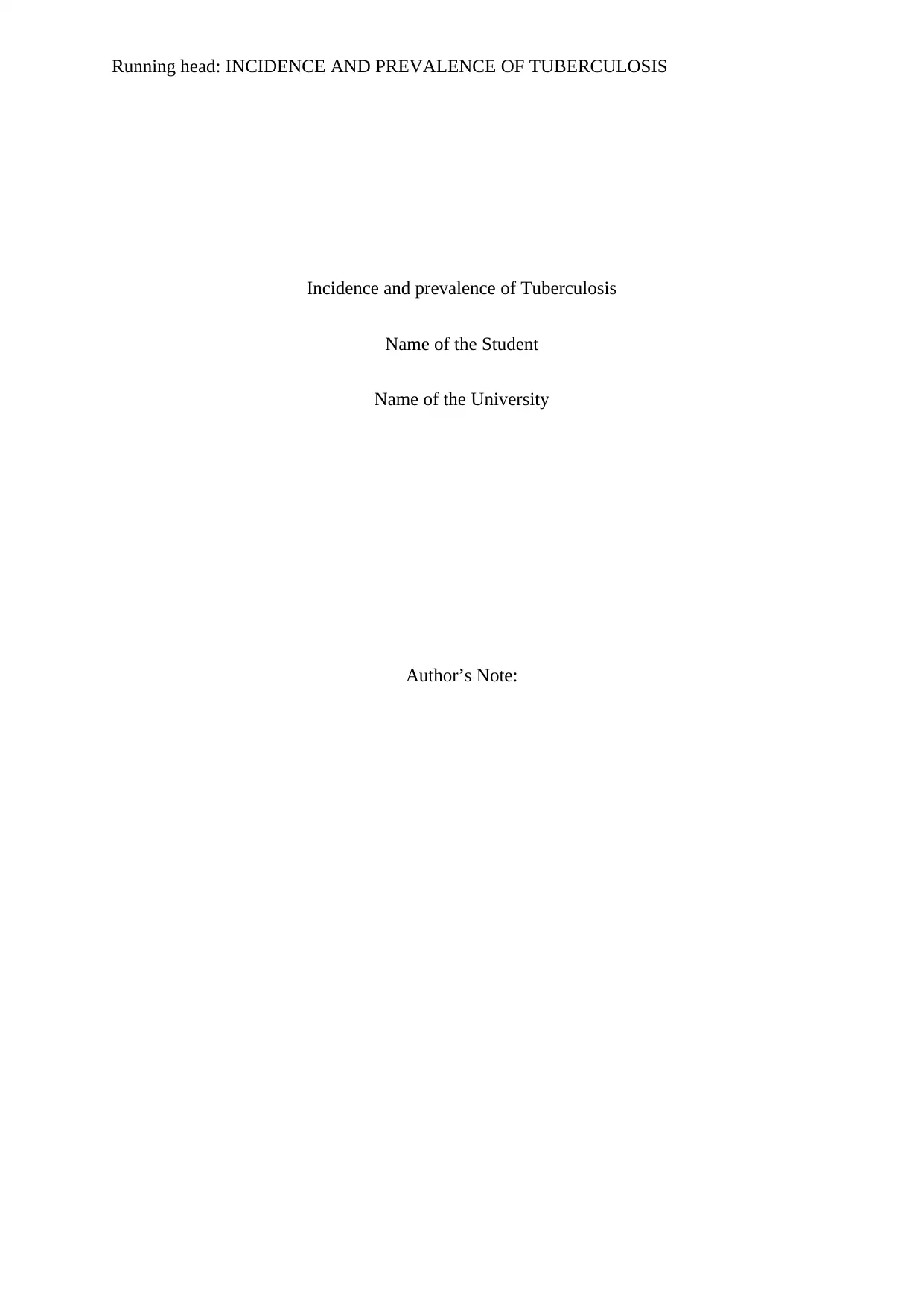
Running head: INCIDENCE AND PREVALENCE OF TUBERCULOSIS
Incidence and prevalence of Tuberculosis
Name of the Student
Name of the University
Author’s Note:
Incidence and prevalence of Tuberculosis
Name of the Student
Name of the University
Author’s Note:
Paraphrase This Document
Need a fresh take? Get an instant paraphrase of this document with our AI Paraphraser
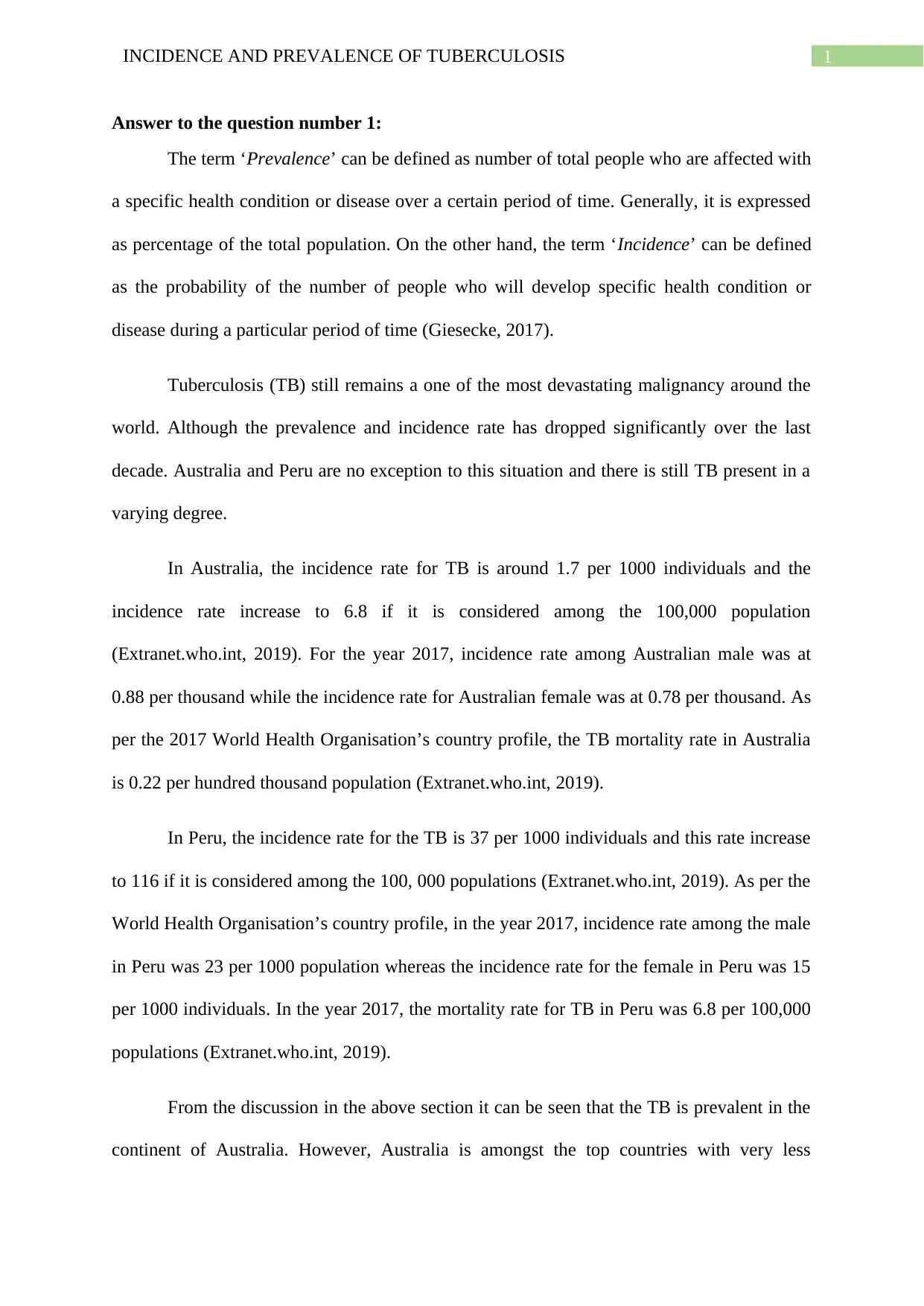
1INCIDENCE AND PREVALENCE OF TUBERCULOSIS
Answer to the question number 1:
The term ‘Prevalence’ can be defined as number of total people who are affected with
a specific health condition or disease over a certain period of time. Generally, it is expressed
as percentage of the total population. On the other hand, the term ‘Incidence’ can be defined
as the probability of the number of people who will develop specific health condition or
disease during a particular period of time (Giesecke, 2017).
Tuberculosis (TB) still remains a one of the most devastating malignancy around the
world. Although the prevalence and incidence rate has dropped significantly over the last
decade. Australia and Peru are no exception to this situation and there is still TB present in a
varying degree.
In Australia, the incidence rate for TB is around 1.7 per 1000 individuals and the
incidence rate increase to 6.8 if it is considered among the 100,000 population
(Extranet.who.int, 2019). For the year 2017, incidence rate among Australian male was at
0.88 per thousand while the incidence rate for Australian female was at 0.78 per thousand. As
per the 2017 World Health Organisation’s country profile, the TB mortality rate in Australia
is 0.22 per hundred thousand population (Extranet.who.int, 2019).
In Peru, the incidence rate for the TB is 37 per 1000 individuals and this rate increase
to 116 if it is considered among the 100, 000 populations (Extranet.who.int, 2019). As per the
World Health Organisation’s country profile, in the year 2017, incidence rate among the male
in Peru was 23 per 1000 population whereas the incidence rate for the female in Peru was 15
per 1000 individuals. In the year 2017, the mortality rate for TB in Peru was 6.8 per 100,000
populations (Extranet.who.int, 2019).
From the discussion in the above section it can be seen that the TB is prevalent in the
continent of Australia. However, Australia is amongst the top countries with very less
Answer to the question number 1:
The term ‘Prevalence’ can be defined as number of total people who are affected with
a specific health condition or disease over a certain period of time. Generally, it is expressed
as percentage of the total population. On the other hand, the term ‘Incidence’ can be defined
as the probability of the number of people who will develop specific health condition or
disease during a particular period of time (Giesecke, 2017).
Tuberculosis (TB) still remains a one of the most devastating malignancy around the
world. Although the prevalence and incidence rate has dropped significantly over the last
decade. Australia and Peru are no exception to this situation and there is still TB present in a
varying degree.
In Australia, the incidence rate for TB is around 1.7 per 1000 individuals and the
incidence rate increase to 6.8 if it is considered among the 100,000 population
(Extranet.who.int, 2019). For the year 2017, incidence rate among Australian male was at
0.88 per thousand while the incidence rate for Australian female was at 0.78 per thousand. As
per the 2017 World Health Organisation’s country profile, the TB mortality rate in Australia
is 0.22 per hundred thousand population (Extranet.who.int, 2019).
In Peru, the incidence rate for the TB is 37 per 1000 individuals and this rate increase
to 116 if it is considered among the 100, 000 populations (Extranet.who.int, 2019). As per the
World Health Organisation’s country profile, in the year 2017, incidence rate among the male
in Peru was 23 per 1000 population whereas the incidence rate for the female in Peru was 15
per 1000 individuals. In the year 2017, the mortality rate for TB in Peru was 6.8 per 100,000
populations (Extranet.who.int, 2019).
From the discussion in the above section it can be seen that the TB is prevalent in the
continent of Australia. However, Australia is amongst the top countries with very less
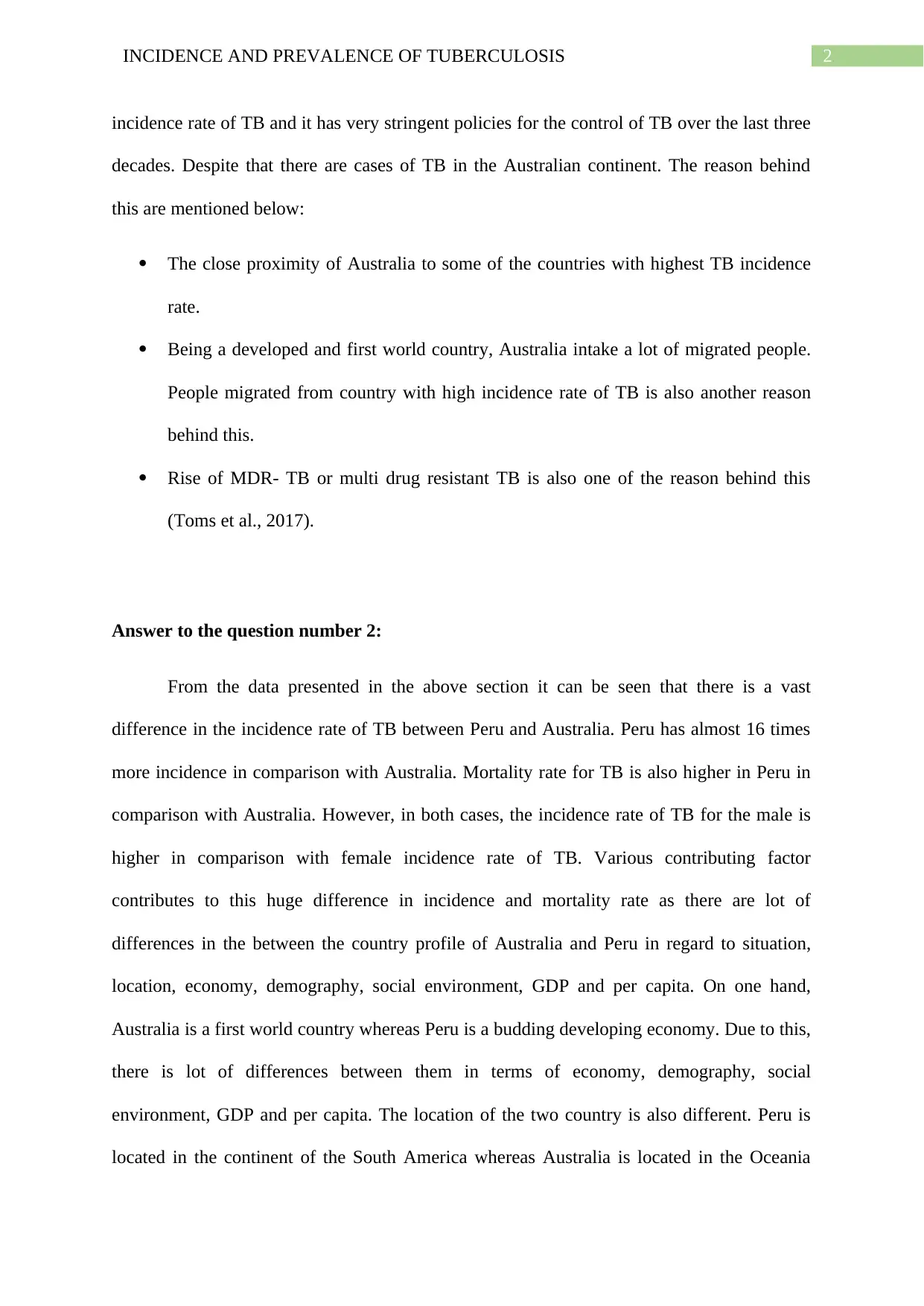
2INCIDENCE AND PREVALENCE OF TUBERCULOSIS
incidence rate of TB and it has very stringent policies for the control of TB over the last three
decades. Despite that there are cases of TB in the Australian continent. The reason behind
this are mentioned below:
The close proximity of Australia to some of the countries with highest TB incidence
rate.
Being a developed and first world country, Australia intake a lot of migrated people.
People migrated from country with high incidence rate of TB is also another reason
behind this.
Rise of MDR- TB or multi drug resistant TB is also one of the reason behind this
(Toms et al., 2017).
Answer to the question number 2:
From the data presented in the above section it can be seen that there is a vast
difference in the incidence rate of TB between Peru and Australia. Peru has almost 16 times
more incidence in comparison with Australia. Mortality rate for TB is also higher in Peru in
comparison with Australia. However, in both cases, the incidence rate of TB for the male is
higher in comparison with female incidence rate of TB. Various contributing factor
contributes to this huge difference in incidence and mortality rate as there are lot of
differences in the between the country profile of Australia and Peru in regard to situation,
location, economy, demography, social environment, GDP and per capita. On one hand,
Australia is a first world country whereas Peru is a budding developing economy. Due to this,
there is lot of differences between them in terms of economy, demography, social
environment, GDP and per capita. The location of the two country is also different. Peru is
located in the continent of the South America whereas Australia is located in the Oceania
incidence rate of TB and it has very stringent policies for the control of TB over the last three
decades. Despite that there are cases of TB in the Australian continent. The reason behind
this are mentioned below:
The close proximity of Australia to some of the countries with highest TB incidence
rate.
Being a developed and first world country, Australia intake a lot of migrated people.
People migrated from country with high incidence rate of TB is also another reason
behind this.
Rise of MDR- TB or multi drug resistant TB is also one of the reason behind this
(Toms et al., 2017).
Answer to the question number 2:
From the data presented in the above section it can be seen that there is a vast
difference in the incidence rate of TB between Peru and Australia. Peru has almost 16 times
more incidence in comparison with Australia. Mortality rate for TB is also higher in Peru in
comparison with Australia. However, in both cases, the incidence rate of TB for the male is
higher in comparison with female incidence rate of TB. Various contributing factor
contributes to this huge difference in incidence and mortality rate as there are lot of
differences in the between the country profile of Australia and Peru in regard to situation,
location, economy, demography, social environment, GDP and per capita. On one hand,
Australia is a first world country whereas Peru is a budding developing economy. Due to this,
there is lot of differences between them in terms of economy, demography, social
environment, GDP and per capita. The location of the two country is also different. Peru is
located in the continent of the South America whereas Australia is located in the Oceania
⊘ This is a preview!⊘
Do you want full access?
Subscribe today to unlock all pages.

Trusted by 1+ million students worldwide
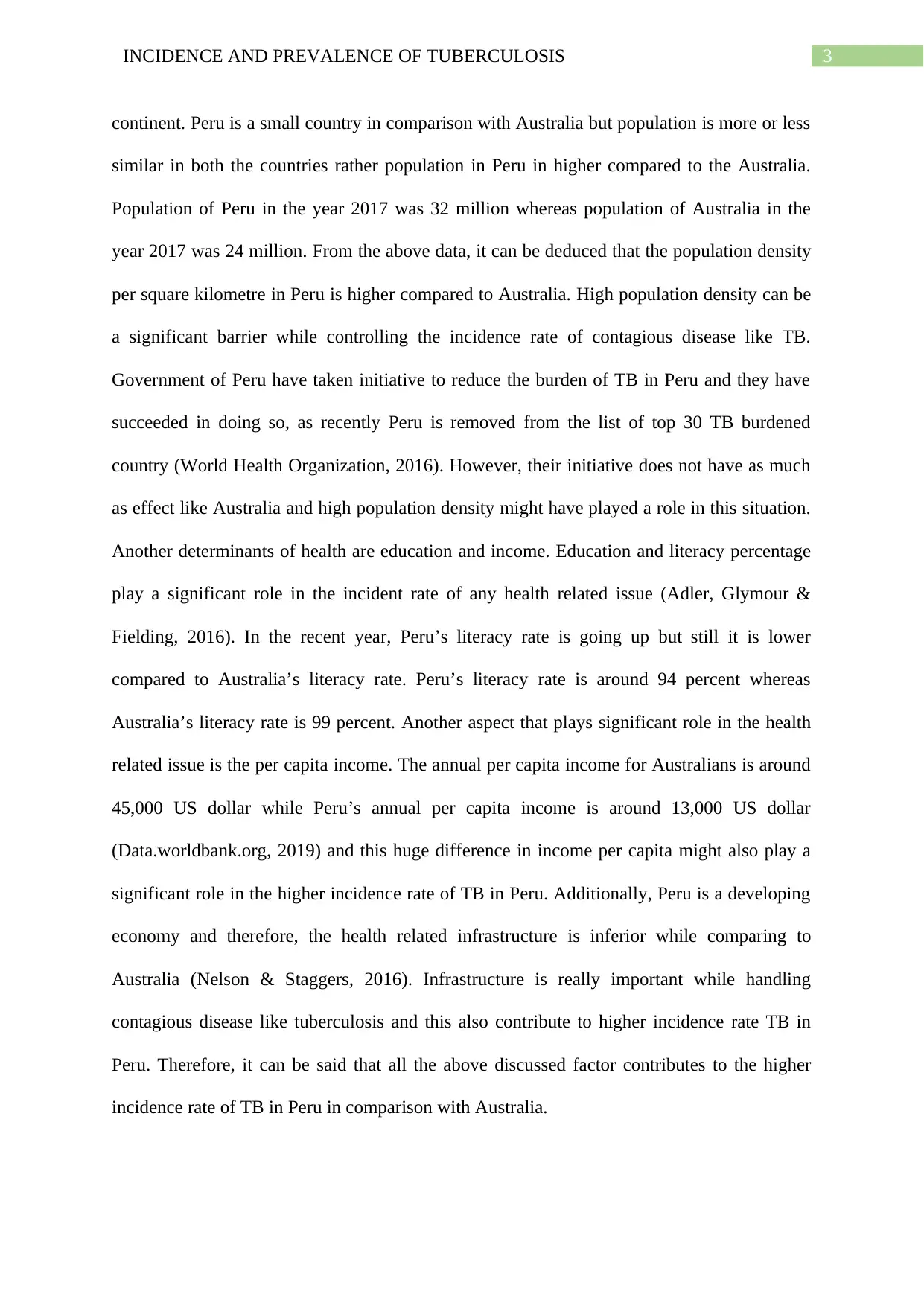
3INCIDENCE AND PREVALENCE OF TUBERCULOSIS
continent. Peru is a small country in comparison with Australia but population is more or less
similar in both the countries rather population in Peru in higher compared to the Australia.
Population of Peru in the year 2017 was 32 million whereas population of Australia in the
year 2017 was 24 million. From the above data, it can be deduced that the population density
per square kilometre in Peru is higher compared to Australia. High population density can be
a significant barrier while controlling the incidence rate of contagious disease like TB.
Government of Peru have taken initiative to reduce the burden of TB in Peru and they have
succeeded in doing so, as recently Peru is removed from the list of top 30 TB burdened
country (World Health Organization, 2016). However, their initiative does not have as much
as effect like Australia and high population density might have played a role in this situation.
Another determinants of health are education and income. Education and literacy percentage
play a significant role in the incident rate of any health related issue (Adler, Glymour &
Fielding, 2016). In the recent year, Peru’s literacy rate is going up but still it is lower
compared to Australia’s literacy rate. Peru’s literacy rate is around 94 percent whereas
Australia’s literacy rate is 99 percent. Another aspect that plays significant role in the health
related issue is the per capita income. The annual per capita income for Australians is around
45,000 US dollar while Peru’s annual per capita income is around 13,000 US dollar
(Data.worldbank.org, 2019) and this huge difference in income per capita might also play a
significant role in the higher incidence rate of TB in Peru. Additionally, Peru is a developing
economy and therefore, the health related infrastructure is inferior while comparing to
Australia (Nelson & Staggers, 2016). Infrastructure is really important while handling
contagious disease like tuberculosis and this also contribute to higher incidence rate TB in
Peru. Therefore, it can be said that all the above discussed factor contributes to the higher
incidence rate of TB in Peru in comparison with Australia.
continent. Peru is a small country in comparison with Australia but population is more or less
similar in both the countries rather population in Peru in higher compared to the Australia.
Population of Peru in the year 2017 was 32 million whereas population of Australia in the
year 2017 was 24 million. From the above data, it can be deduced that the population density
per square kilometre in Peru is higher compared to Australia. High population density can be
a significant barrier while controlling the incidence rate of contagious disease like TB.
Government of Peru have taken initiative to reduce the burden of TB in Peru and they have
succeeded in doing so, as recently Peru is removed from the list of top 30 TB burdened
country (World Health Organization, 2016). However, their initiative does not have as much
as effect like Australia and high population density might have played a role in this situation.
Another determinants of health are education and income. Education and literacy percentage
play a significant role in the incident rate of any health related issue (Adler, Glymour &
Fielding, 2016). In the recent year, Peru’s literacy rate is going up but still it is lower
compared to Australia’s literacy rate. Peru’s literacy rate is around 94 percent whereas
Australia’s literacy rate is 99 percent. Another aspect that plays significant role in the health
related issue is the per capita income. The annual per capita income for Australians is around
45,000 US dollar while Peru’s annual per capita income is around 13,000 US dollar
(Data.worldbank.org, 2019) and this huge difference in income per capita might also play a
significant role in the higher incidence rate of TB in Peru. Additionally, Peru is a developing
economy and therefore, the health related infrastructure is inferior while comparing to
Australia (Nelson & Staggers, 2016). Infrastructure is really important while handling
contagious disease like tuberculosis and this also contribute to higher incidence rate TB in
Peru. Therefore, it can be said that all the above discussed factor contributes to the higher
incidence rate of TB in Peru in comparison with Australia.
Paraphrase This Document
Need a fresh take? Get an instant paraphrase of this document with our AI Paraphraser
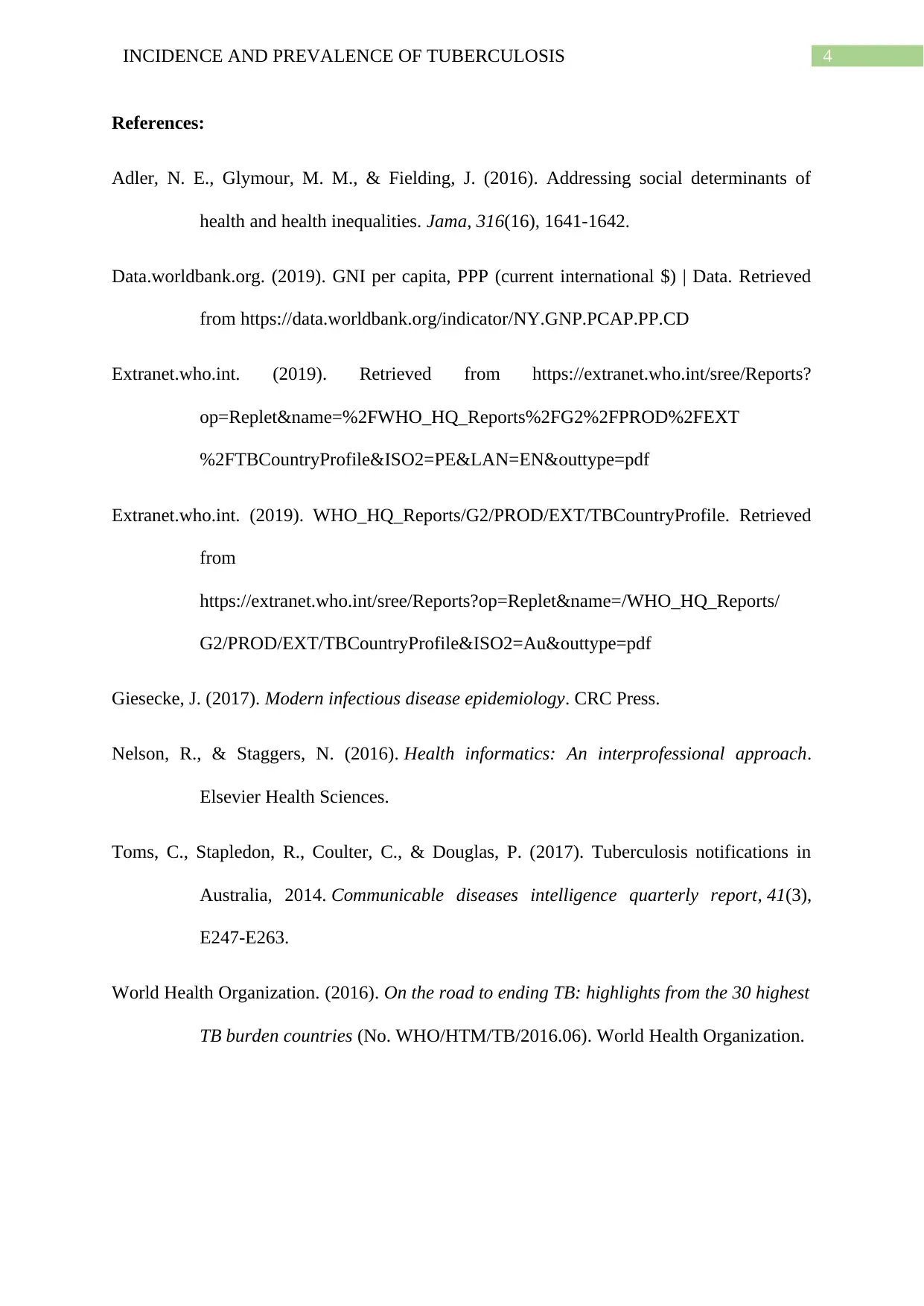
4INCIDENCE AND PREVALENCE OF TUBERCULOSIS
References:
Adler, N. E., Glymour, M. M., & Fielding, J. (2016). Addressing social determinants of
health and health inequalities. Jama, 316(16), 1641-1642.
Data.worldbank.org. (2019). GNI per capita, PPP (current international $) | Data. Retrieved
from https://data.worldbank.org/indicator/NY.GNP.PCAP.PP.CD
Extranet.who.int. (2019). Retrieved from https://extranet.who.int/sree/Reports?
op=Replet&name=%2FWHO_HQ_Reports%2FG2%2FPROD%2FEXT
%2FTBCountryProfile&ISO2=PE&LAN=EN&outtype=pdf
Extranet.who.int. (2019). WHO_HQ_Reports/G2/PROD/EXT/TBCountryProfile. Retrieved
from
https://extranet.who.int/sree/Reports?op=Replet&name=/WHO_HQ_Reports/
G2/PROD/EXT/TBCountryProfile&ISO2=Au&outtype=pdf
Giesecke, J. (2017). Modern infectious disease epidemiology. CRC Press.
Nelson, R., & Staggers, N. (2016). Health informatics: An interprofessional approach.
Elsevier Health Sciences.
Toms, C., Stapledon, R., Coulter, C., & Douglas, P. (2017). Tuberculosis notifications in
Australia, 2014. Communicable diseases intelligence quarterly report, 41(3),
E247-E263.
World Health Organization. (2016). On the road to ending TB: highlights from the 30 highest
TB burden countries (No. WHO/HTM/TB/2016.06). World Health Organization.
References:
Adler, N. E., Glymour, M. M., & Fielding, J. (2016). Addressing social determinants of
health and health inequalities. Jama, 316(16), 1641-1642.
Data.worldbank.org. (2019). GNI per capita, PPP (current international $) | Data. Retrieved
from https://data.worldbank.org/indicator/NY.GNP.PCAP.PP.CD
Extranet.who.int. (2019). Retrieved from https://extranet.who.int/sree/Reports?
op=Replet&name=%2FWHO_HQ_Reports%2FG2%2FPROD%2FEXT
%2FTBCountryProfile&ISO2=PE&LAN=EN&outtype=pdf
Extranet.who.int. (2019). WHO_HQ_Reports/G2/PROD/EXT/TBCountryProfile. Retrieved
from
https://extranet.who.int/sree/Reports?op=Replet&name=/WHO_HQ_Reports/
G2/PROD/EXT/TBCountryProfile&ISO2=Au&outtype=pdf
Giesecke, J. (2017). Modern infectious disease epidemiology. CRC Press.
Nelson, R., & Staggers, N. (2016). Health informatics: An interprofessional approach.
Elsevier Health Sciences.
Toms, C., Stapledon, R., Coulter, C., & Douglas, P. (2017). Tuberculosis notifications in
Australia, 2014. Communicable diseases intelligence quarterly report, 41(3),
E247-E263.
World Health Organization. (2016). On the road to ending TB: highlights from the 30 highest
TB burden countries (No. WHO/HTM/TB/2016.06). World Health Organization.
1 out of 5
Related Documents
Your All-in-One AI-Powered Toolkit for Academic Success.
+13062052269
info@desklib.com
Available 24*7 on WhatsApp / Email
![[object Object]](/_next/static/media/star-bottom.7253800d.svg)
Unlock your academic potential
Copyright © 2020–2025 A2Z Services. All Rights Reserved. Developed and managed by ZUCOL.





